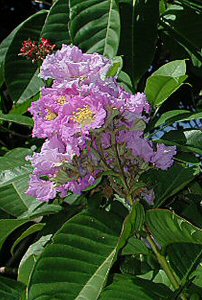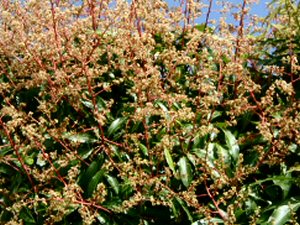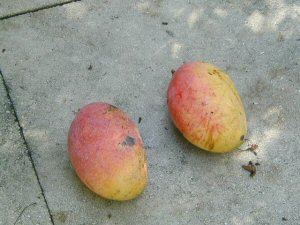

Over the Top
The seasons in a subtropical garden
The gingers, that gave some sneak previews with a few species in flower earlier in the year, now really come into their own. The kaempferias treasured earlier as each new leaf unfurled, now jostle in their planting beds, pushing out leaves as though intent on shading out their neighbours ( as indeed they would since they are programmed for survival, and not losing any of their share of the light is part of that program).
Globbas, with their 'dancing lady' flowers offer yellow, white or purple blooms together with brightly coloured bracts and sometimes red-backed leaves.


A major player in the garden throughout the year is a fine old mango tree, that was huge when we came to the house. It fills one corner of the garden, and is a good site for orchids planted on its trunk and branches. They flower reliably, even though the shade is a little too dense to be ideal.
| The tree itself flowers in the early spring, sometimes early enough that a late cold spell will blacken many of the flowers, but more often at a time when the canopy becomes alive with insect visitors that between them pollinate far more fruit than the tree can support. |  |
Nature takes care of this, producing a steady shower of discarded fruit that begin the size of a pinhead and continue until they are like small peas. Then the remainder begin to swell steadily, with another adjustment coming at broad bean size and another at the size of a small mouse.
 |
Then comes the wait as the fruits, which by now are far too heavy to be held upright, swell on their hanging streamers. When the heat of summer is pressing on the garden, and even mad dogs will not go out at midday, growth has finished and ripening begins. |
Now this is not the way to grow mangoes for the house. Picture the whole crop fifteen to twenty feet in the air, and no possible way to reach them to pick. Each fruit of this particular variety (Springfels) weighs up to two pounds, and the picture that I should be presenting is of a time of great hazard in the garden for cats and people, and, in particular, for the plants under the tree that cannot get out of the way of these honeyed bombs that eventually come crashing down with no warning.
|
They are still good to eat, even if they miss the areas with heavy mulch and split, but one or two will feed a family, and in a good year there are several hundred, all ripening in a three to four week period. The image to the right is of almost six pounds of mango, sweet and delicious and ready to go. If ours were the only mango tree in South Florida, there would be no problem disposing of the crop, but many people have their own trees, so sharing the wealth is about as difficult as getting rid of marrows from our allotment at the end of the season used to be when I was growing up in London. |
 |
Summer is definitely the time to separate the men from the boys when it comes to gardening- or perhaps it is more a test of smarts versus stubborn. I hate to be defeated, but the air-conditioning certainly has a seductive voice when the temperature and humidity rise to numbers about the same as my I.Q.
On to a little more of the garden story
Back to the beginning of the small garden story
|
|